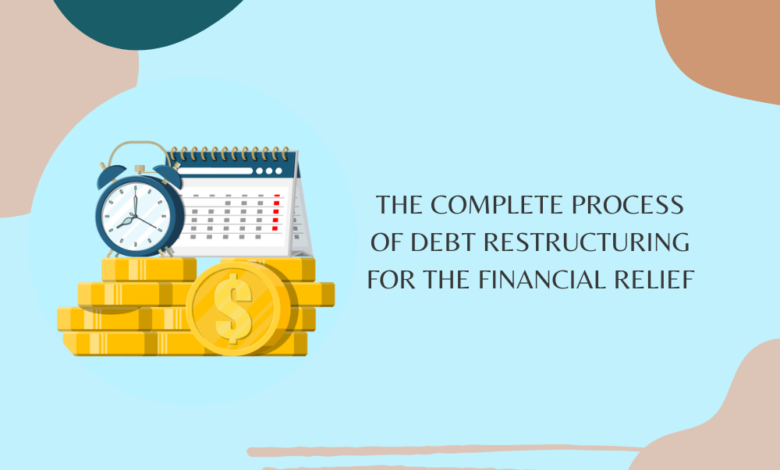The Complete Process of Debt Restructuring For the Financial Relief

Introduction to Debt Restructuring
Debt restructuring is a method by which a debtor and creditor agree to modify the terms of an existing debt. This process can involve changing the interest rate, extending the repayment period, or reducing the principal amount owed. The goal of debt restructuring is to make debt repayment more manageable, preventing default and enabling the debtor to achieve financial stability. For many, understanding the steps followed by Debt Restructuring Companies towards financial relief and recovery.
Debt can become a crushing burden, leading to sleepless nights and constant worry. For individuals and businesses alike, debt restructuring offers a pathway to manage overwhelming financial obligations more effectively. But what exactly does debt restructuring involve, and how can it help you regain control of your finances? This article delves into the intricate process of debt restructuring, providing a clear roadmap to help you navigate this complex yet potentially life-changing strategy.
Assessing the Financial Situation
The first crucial step in the debt restructuring process is a thorough assessment of the current financial situation. This involves taking a comprehensive look at all debts, income sources, expenses, and assets. For individuals, this might mean gathering credit card statements, loan agreements, and any other financial documentation. For businesses, this includes analyzing financial statements, cash flow projections, and outstanding liabilities. This assessment provides a clear picture of the financial landscape and helps identify the specific issues that need to be addressed through restructuring.
Identifying the Need for Restructuring
After assessing the financial situation, the next step is to determine whether debt restructuring is necessary and appropriate. Common indicators that restructuring may be needed include:
- Difficulty making minimum monthly payments
- High debt-to-income ratio
- Frequent use of credit to cover basic expenses
- Calls from creditors and collection agencies
- Potential for default on loans
For businesses, signs might include declining revenue, cash flow problems, or the inability to meet payroll and operational expenses. Recognizing these signs early can prevent further financial deterioration and enable a proactive approach to debt management.
Exploring Debt Restructuring Options
Once the need for debt restructuring is established, it’s essential to explore the various options available. Debt restructuring can take several forms, including:
- Interest Rate Reduction: Negotiating with creditors to lower the interest rate on existing debts can reduce monthly payments and the total amount paid over time.
- Extension of Repayment Terms: Lengthening the repayment period can lower monthly payments, making them more manageable.
- Debt Forgiveness: In some cases, creditors may agree to forgive a portion of the principal amount owed, reducing the overall debt burden.
- Debt Consolidation: Combining multiple debts into a single loan with a lower interest rate and longer repayment term.
Each option has its advantages and disadvantages, and the best choice will depend on the specific financial situation and goals of the debtor.
Preparing a Debt Restructuring Proposal
With a clear understanding of the available options, the next step is to prepare a debt restructuring proposal. This proposal outlines the debtor’s current financial situation, the restructuring options being sought, and the expected benefits for both the debtor and the creditors. It should include detailed financial statements, cash flow projections, and a plan for meeting the restructured payment terms. A well-prepared proposal demonstrates the debtor’s commitment to repaying the debt and can facilitate more productive negotiations with creditors.
Negotiating with Creditors
Negotiation is a critical part of the debt restructuring process. It involves communicating with creditors to present the restructuring proposal and reach an agreement on modified terms. Effective negotiation requires transparency, honesty, and a clear demonstration of the debtor’s financial situation and repayment capacity. Key elements to discuss during negotiations include:
- Interest Rates: Proposing a lower interest rate to reduce monthly payments.
- Repayment Schedule: Extending the repayment period to make payments more manageable.
- Principal Reduction: Requesting forgiveness of a portion of the principal amount owed.
Successful negotiations result in an agreement that benefits both the debtor and the creditors, ensuring that the debtor can meet their obligations while the creditors receive repayment on more favorable terms.

Implementing the Restructured Terms
Once an agreement is reached, the next step is to implement the restructured terms. This involves adjusting the payment schedule, updating financial records, and ensuring that all parties understand the new terms. For individuals, this might mean setting up automatic payments to ensure timely repayments. For businesses, it involves updating accounting systems and financial plans to reflect the new repayment terms. It’s crucial to adhere to the agreed-upon terms to maintain the benefits of the restructuring and avoid future financial difficulties.
Monitoring and Adjusting the Plan
Debt restructuring is not a one-time event but an ongoing process that requires regular monitoring and adjustments. It’s essential to track progress and ensure that the restructured terms are being met. For individuals, this involves regularly reviewing budgets and financial statements to stay on track with repayments. For businesses, it includes ongoing cash flow management and financial planning. If financial circumstances change, it may be necessary to revisit and adjust the restructuring plan to ensure continued financial stability.
Benefits of Debt Restructuring
Debt restructuring offers several significant benefits, including:
- Lower Monthly Payments: Reduced interest rates and extended repayment terms can lower monthly payments, making them more manageable.
- Avoidance of Default: Restructuring helps prevent default, protecting the debtor’s credit rating and financial reputation.
- Improved Cash Flow: By lowering monthly payments, restructuring can improve cash flow, providing more financial flexibility.
- Financial Stability: Effective restructuring can lead to long-term financial stability, enabling the debtor to meet their obligations and achieve financial goals.
Understanding these benefits can motivate individuals and businesses to seek debt restructuring and take proactive steps towards financial recovery.
Potential Risks and Considerations
While debt restructuring offers many benefits, it’s important to be aware of potential risks and considerations. These include:
- Impact on Credit Rating: Restructuring can impact credit ratings, especially if it involves debt forgiveness or significant changes to the repayment terms.
- Cost of Restructuring: Some restructuring options may involve fees or additional costs, which should be carefully considered.
- Commitment to New Terms: Adhering to the restructured terms is crucial for maintaining the benefits of restructuring and avoiding further financial difficulties.
Weighing these risks against the potential benefits can help individuals and businesses make informed decisions about debt restructuring.
Conclusion: A Path to Financial Recovery
Debt restructuring offers a viable pathway for individuals and businesses struggling with overwhelming financial obligations. By assessing the financial situation, exploring restructuring options, and negotiating with creditors, debtors can achieve more manageable repayment terms and avoid default. The benefits of restructuring, including lower monthly payments, improved cash flow, and financial stability, make it an attractive option for those seeking relief from debt.
Taking the first step towards debt restructuring can be challenging, but with the right approach and professional guidance, it is possible to regain control of your finances and build a secure financial future. Understanding the process and being proactive can lead to successful debt management and long-term financial recovery. This comprehensive guide provides a detailed overview of the debt restructuring process, highlighting the steps involved and the benefits it offers. By understanding the intricacies of debt restructuring, individuals and businesses can take informed steps towards financial stability and recovery.
Note :- To Read More Articles Visit on- usafulnews



